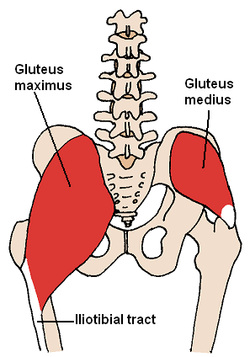Gluteus Medius
Original Editor - Alex Palmer,
Top Contributors - Alex Palmer, George Prudden, Kim Jackson, Ahmed Nasr, Joao Costa, Joanne Garvey, Candace Goh, Nupur Smit Shah, WikiSysop, Kai A. Sigel, Vidya Acharya, Pinar Kisacik, Rachael Lowe and Evan Thomas;
Description[edit | edit source]
Gluteus medius is located on lateral aspect of the upper buttock, below the iliac crest. The superior muscle is broad with the muscle narrowing towards its insertional tendon giving it a fan-shape. Posteriorly, the muscle is overlapped by the gluteus maximus. Gluteus medius is an important muscle in walking, running and single leg weight-bearing.[1] Weakness in this muscle has been associated with lower-limb musculoskeletal pathology[2] and gait disturbance following stroke.[3]
Anatomy[edit | edit source]
Origin[edit | edit source]
Gluteal, or lateral surface of the ilium between the posterior and anterior gluteal lines. This is a large area, reaching from the iliac crest above to the almost the sciatic notch below.[1]
Insertion
[edit | edit source]
Posterior fibres pass forwards and downwards, the middle fibres downwards, anterior fibres pass backwards and downwards. Fibres combine to form a flatterned tendon which attaches to the superlateral side of the greater trochanter of the femur.[1]
Nerve supply[edit | edit source]
The gluteus medius is supplied by the superior gluteal nerve (root L4, 5 and S1). Cutaneous supply is mainly provided by L1 and 2.[1]
Function[edit | edit source]
Gluteus medius acts to abduct and medially rotate the hip.
Maintaining single-leg stance is required during walking and running. When a limb is taken off the ground the pelvis on the opposite side will tend to drop through loss of support from below. Gluteus medius works to maintain the side of the pelvis that drops therefore allowing the other limb to swing forward for the next step. Gluteus_Minimus
Gluteus medius also supports the pelvis during gait by producing rotation of hip with assitance from gluteus minimus and tensor fascia lata. Conversely, the hip is supported during the stance phase by acting on on the same side.
The Trendelenburg sign is when the muscle is unable to work efficently due to pain, poor mechanics or weakness, the pelvis will drop on the opposite side to the weakness.
Assessment[edit | edit source]
Palpation[edit | edit source]
Power[edit | edit source]
Length[edit | edit source]
Treatment[edit | edit source]
Resourses[edit | edit source]
See also[edit | edit source]
Greater trochanteric pain syndrone
Recent Related Research (from Pubmed)[edit | edit source]
References[edit | edit source]
- ↑ 1.0 1.1 1.2 1.3 Palastanga N, Soames R. Anatomy and Human Movement: Structure and Function. 6th ed. London, United Kingdom: Churchill Livingstone; 2012.
- ↑ Barton CJ, Lack S, Malliaras P, Morrissey D. Gluteal muscle activity and patellofemoral pain syndrome: a systematic review. British journal of sports medicine. 2012 Sep 3:bjsports-2012.
- ↑ Buurke JH, Nene AV, Kwakkel G, Erren-Wolters V, IJzerman MJ, Hermens HJ. Recovery of gait after stroke: what changes?. Neurorehabilitation and Neural Repair. 2008 Nov 1;22(6):676-83.







